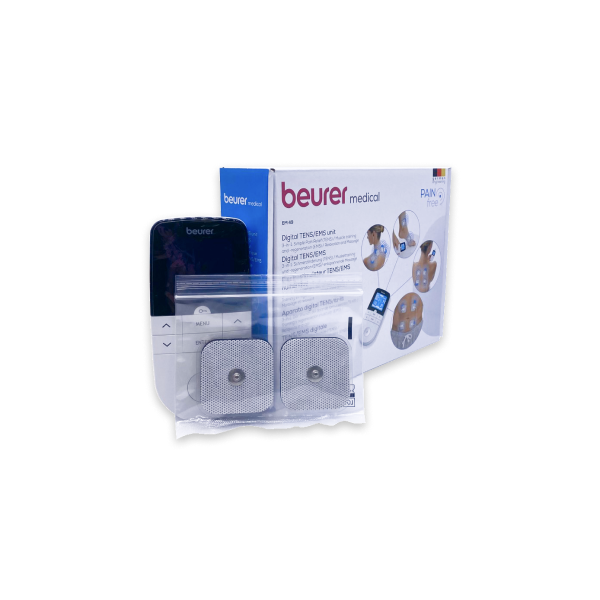TENS Machine






Price Checker
Please select the product variation first.

About the product
A TENS Machine (Transcutaneous Electrical Nerve Stimulation) is a portable device used for pain relief. It works by sending mild electrical impulses through electrodes placed on the skin, which stimulate the nerves in the affected area. These impulses can help block pain signals from reaching the brain and encourage the release of endorphins, the body’s natural painkillers. TENS machines are commonly used to manage chronic pain, muscle and joint pain, period pain, and pain from injuries. Compact and easy to use at home, they provide a drug-free, non-invasive option for managing discomfort and improving day-to-day quality of life.
Overview
FAQ
Directions
Side Effects
How it works
Delivery
Ingredients
Warnings
Overview
A TENS machine (Transcutaneous Electrical Nerve Stimulation) is a small, battery-operated device used to relieve pain. It works by sending mild electrical impulses through electrodes placed on the skin, which can help reduce the perception of pain. TENS machines are often used for back pain, arthritis, and muscle discomfort.
Frequently Asked Questions
Have a question? We're here to help
What are the benefits of TENS treatment?
The benefits of using a TENS machine include drug-free pain relief, reduced muscle tension, and improved mobility. Many people find it particularly helpful for chronic conditions such as arthritis or sciatica. Furthermore, TENS can be used at home and tailored to your comfort.
Does TENS reduce inflammation?
A TENS machine doesn’t directly treat inflammation, but it can help reduce pain and improve comfort, which may make inflamed areas feel better. By blocking pain signals, it allows you to move more freely.
Is a TENS unit good for nerves?
Yes, TENS can be helpful for certain types of nerve pain by interfering with pain signals sent to the brain. While it doesn’t repair nerves, it can reduce discomfort and improve quality of life.
How many minutes should I use TENS?
Most people use a TENS machine for 15–30 minutes at a time, up to several times per day. Always start with shorter sessions and increase gradually. You should avoid leaving the pads on for very long periods to prevent skin irritation.
How long should you use a TENS unit?
A TENS machine can be used regularly, as long as each session is within the recommended duration. Some people use it daily for chronic pain, while others use it only when needed
Where do you put the TENS unit for pleasure?
TENS machines are not designed for sexual pleasure and should not be used in this way. Misuse may cause harm or discomfort. They are intended for pain relief only.
Where to put TENS machine for lower back pain?
For lower back pain, place the electrode pads on either side of the painful area, not directly on the spine. Positioning the pads correctly ensures effective relief.
How high should it set my TENS unit?
Set your TENS machine to a comfortable tingling sensation, but not so high that it causes pain. The correct setting varies by individual. It is recommended to start on a low intensity and increase gradually.
Is TENS good for sciatica?
Yes, many people find that TENS helps relieve sciatic pain by blocking pain signals and relaxing tense muscles. While it won’t cure sciatica, it may ease discomfort during flare-ups.
Does TENS work for sciatica?
Yes, TENS is often used as part of pain management for sciatica. The electrical impulses can provide temporary relief, although results vary by individual. It is most effective when combined with other treatments recommended by your doctor.
Is TENS good for arthritis?
TENS is commonly used for arthritis pain. It provides drug-free relief and can be applied at home, making it suitable for ongoing management of chronic joint pain.
Where to put TENS pads for lower back pain?
For lower back pain, place two pads on either side of the pain area, avoiding direct placement on the spine. This helps target the nerves effectively.
Where to put TENS machine for period pain?
For period pain, place the TENS pads on the lower abdomen or lower back, depending on where the cramps are most intense. Many women find this method reduces discomfort during menstruation.
Where should you not use a TENS unit?
Do not place TENS pads on your eyes, throat, chest, genitals, or broken skin. Avoid using it if you have a pacemaker or other implanted device unless advised by a doctor.
What is the disadvantage of TENS?
The main disadvantage of TENS is that it only provides temporary pain relief and doesn’t treat the underlying cause of pain. Some people may also experience skin irritation or find it ineffective.
Where should you not put a TENS unit on your neck?
You should avoid placing TENS pads directly on the front or sides of your neck, as this can affect important nerves and blood vessels. If you need relief for neck pain, place the pads on the upper back or shoulders instead.
Should muscles twitch when using TENS?
Mild twitching may occur at higher settings, but the goal of TENS is a tingling sensation, not muscle contraction. If twitching is uncomfortable, reduce the intensity.
Does TENS loosen tight muscles?
Yes, TENS may help relax tight muscles by improving blood flow and reducing pain signals. It is often used for muscle tension and stiffness
Is a TENS machine good for your muscles?
TENS machines don’t strengthen muscles but can help reduce pain and tension, making movement easier. For muscle rehabilitation, other therapies may be needed
Does TENS heal or just mask pain?
TENS does not heal the underlying cause of pain – it provides temporary relief by blocking pain signals and releasing endorphins. This can make it easier to move and manage daily activities.
Do TENS units relax muscles?
Yes, TENS units can relax tense muscles and reduce stiffness, especially when used around the affected area.
Does a TENS machine loosen tight muscles?
Yes, many people find TENS helps loosen tight muscles, particularly in the back, shoulders, and neck.
Can TENS units stimulate bowel movement?
There is no strong evidence that TENS stimulates bowel movements. While some people use it for abdominal pain, it is not intended for constipation relief.
Where do you put TENS pads for constipation?
TENS is not designed for treating constipation. Always seek medical advice before attempting to use a TENS machine for digestive issues.
Is TENS good for IBS?
There is limited evidence on TENS for IBS, but some people report reduced abdominal pain. It is not a standard treatment
Can I use TENS unit on face?
No, TENS should not be used on the face, especially around the eyes or mouth. This can be unsafe and cause harm.
Where to put TENS unit on stomach?
TENS pads can be placed on the stomach for muscle cramps or period pain, but not for digestive conditions. Always follow placement guides provided.
Do TENS units work to build muscle?
No, TENS machines do not build muscle. They are designed for pain relief, not muscle strengthening.
What happens if you use TENS too much?
Excessive use may cause skin irritation, redness, or reduced effectiveness over time. Stick to the recommended session length and frequency.
Can a TENS unit help with gas and bloating?
TENS is not intended for gas or bloating relief.
Where to place TENS unit for anxiety?
There is no medical guidance for using TENS for anxiety. It is not designed to treat mental health conditions.
Directions
The TENS machine device is applied to the skin. Simply place the stick electrode pads on the area where you feel pain, then adjust the settings for comfort. You should always follow the instructions that come with your machine.
Side Effects
TENS machines are generally safe, but mild side effects may include skin irritation, tingling, or redness where the pads are applied. Additionally, some people may find the sensation uncomfortable at higher settings.
How it works
A TENS machine works by delivering small electrical impulses through the skin to stimulate nerves. This can block pain signals from reaching the brain and encouraging the release of natural endorphins. The result is temporary relief from pain and muscle tension.
Delivery
The delivery choices available from Royal Mail include Royal Mail Tracked 48, Royal Mail Tracked 24, and Royal Mail Special Delivery by 1pm. The TENS machine will arrive in discreet and recyclable packaging to your delivery address.
Ingredients
The TENS machine kit typically includes the main handheld unit, electrode pads (containing conductive gel), lead wires, batteries or rechargeable power source, and user instructions. The electrode pads are usually made with a hydrogel adhesive layer, carbon film, and a non-woven fabric backing.
Warnings
You should not use this device if any of the following apply to you:
- If you have a pacemaker, implanted defibrillator, or other implanted electrical device.
- If you have epilepsy or a history of seizures.
- If you are pregnant, unless specifically advised by a healthcare professional.
- If you are allergic to electrode pads or any of the materials used.
Same day dispatch:
0 minutes






